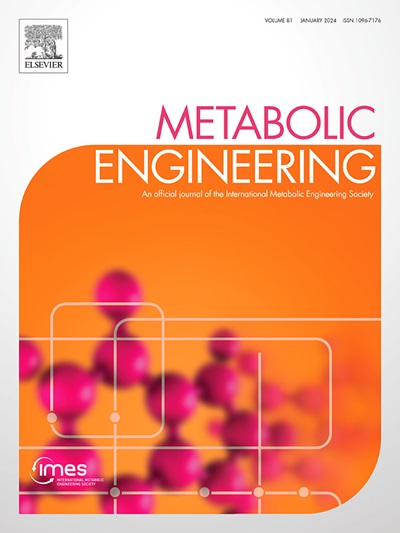Biomass accumulation in chondrocyte metabolic modelling: Incorporating extracellular matrix proxies to predict tissue engineering outcomes
IF 6.8
1区 生物学
Q1 BIOTECHNOLOGY & APPLIED MICROBIOLOGY
引用次数: 0
Abstract
Metabolic modeling in chondrocytes plays a pivotal role in advancing our understanding of cellular function. These techniques have been used to study degenerative joint diseases (e.g. osteoarthritis), mechanotransduction, and more recently to optimize strategies for cartilage tissue engineering. Incorporating tissue formation into metabolic flux analysis is inherently challenging due to the complexity of linking metabolic activity to extracellular matrix (ECM) accumulation. Many ECM macromolecules are synthesized using metabolites derived from central carbon metabolism, but direct modeling of their accumulation remains complex. This study establishes a novel methodology for incorporating ECM synthesis into metabolic flux analysis (MFA). By utilizing chondroitin sulfate and hydroxyproline as measurable metabolic proxies for proteoglycan and collagen production, we demonstrate a framework for linking metabolic inputs with tissue formation. Extracellular flux data for glucose, lactate, carbon dioxide, glutamine, and glutamate, along with mass isotopomer distributions, were sourced from previous studies involving three-dimensional high-density cultures of articular cartilage tissue constructs. Additionally, the conditioned culture media used in these studies was used to quantify the production rates of chondroitin sulfate and hydroxyproline. Using a modular network model, proteoglycan and collagen metabolism were assessed independently, and in combination, with sensitivity analyses on ECM retention assumptions. Predicted proteoglycan production aligned well with previously observed trends; however, predicted collagen production was less consistent. These findings offer a novel approach for linking metabolic inputs with ECM production, advancing our ability to predict tissue formation and address key challenges in cartilage tissue engineering.
软骨细胞代谢模型中的生物量积累:结合细胞外基质代理来预测组织工程结果
软骨细胞的代谢模型在促进我们对细胞功能的理解方面起着关键作用。这些技术已被用于研究退行性关节疾病(如骨关节炎)、机械转导,以及最近用于优化软骨组织工程的策略。由于将代谢活动与细胞外基质(ECM)积累联系起来的复杂性,将组织形成纳入代谢通量分析本身就具有挑战性。许多ECM是利用源自中心碳代谢的代谢物合成的,但对其积累的直接建模仍然很复杂。本研究建立了一种将ECM合成纳入代谢通量分析(MFA)的新方法。通过利用硫酸软骨素和羟脯氨酸作为蛋白聚糖和胶原蛋白生产的可测量代谢代用物,我们展示了一个将代谢输入与组织形成联系起来的框架。葡萄糖、乳酸、二氧化碳、谷氨酰胺和谷氨酸的细胞外通量数据,以及质量同位素分布,来源于先前涉及关节软骨组织构建的三维高密度培养的研究。此外,在这些研究中使用的条件培养基被用来量化硫酸软骨素和羟脯氨酸的产量。使用模块化网络模型,分别评估蛋白聚糖和胶原代谢,并结合ECM保留假设的敏感性分析。预测的蛋白多糖产量与先前观察到的趋势一致;然而,预测的胶原蛋白生成不太一致。这些发现为将代谢输入与ECM产生联系起来提供了一种新的方法,提高了我们预测组织形成的能力,并解决了软骨组织工程中的关键挑战。
本文章由计算机程序翻译,如有差异,请以英文原文为准。
求助全文
约1分钟内获得全文
求助全文
来源期刊

Metabolic engineering
工程技术-生物工程与应用微生物
CiteScore
15.60
自引率
6.00%
发文量
140
审稿时长
44 days
期刊介绍:
Metabolic Engineering (MBE) is a journal that focuses on publishing original research papers on the directed modulation of metabolic pathways for metabolite overproduction or the enhancement of cellular properties. It welcomes papers that describe the engineering of native pathways and the synthesis of heterologous pathways to convert microorganisms into microbial cell factories. The journal covers experimental, computational, and modeling approaches for understanding metabolic pathways and manipulating them through genetic, media, or environmental means. Effective exploration of metabolic pathways necessitates the use of molecular biology and biochemistry methods, as well as engineering techniques for modeling and data analysis. MBE serves as a platform for interdisciplinary research in fields such as biochemistry, molecular biology, applied microbiology, cellular physiology, cellular nutrition in health and disease, and biochemical engineering. The journal publishes various types of papers, including original research papers and review papers. It is indexed and abstracted in databases such as Scopus, Embase, EMBiology, Current Contents - Life Sciences and Clinical Medicine, Science Citation Index, PubMed/Medline, CAS and Biotechnology Citation Index.
 求助内容:
求助内容: 应助结果提醒方式:
应助结果提醒方式:


